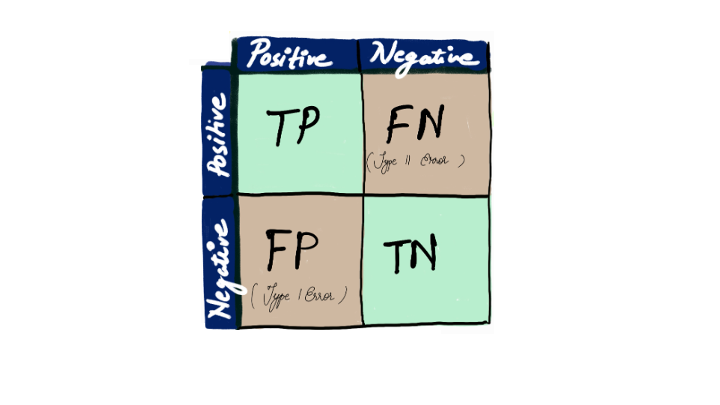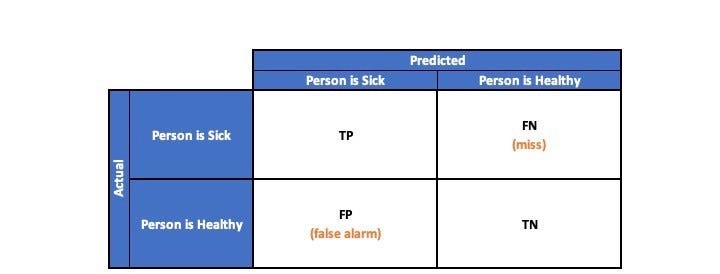
Introduction to Confusion Matrix
Last Updated on July 25, 2023 by Editorial Team
Author(s): Saurabh Saxena
Originally published on Towards AI.
Model Evaluation
What is Confusion Matrix and how to plot it in Python?

The Confusion Matrix is the visual representation of the Actual VS Predicted values. It is a performance evaluation tool for classification algorithms, also known as the error matrix.
A two-dimensional table layout of how many predicted classes or categories were correctly predicted and how many were not allows visualization of the performance of an algorithm, typically in supervised learning.
In predictive analytics, a Confusion Matrix for binary classification is a table with two rows and two columns that reports the number of true positives, false negatives, false positives, and true negatives. This allows for more detailed analysis than simply observing accuracy.

Why Confusion Matrix over Accuracy?
The accuracy metric can be misleading if used for the Imbalance dataset when the numbers of observations in different classes vary greatly. Whereas the Confusion Matrix provides a detailed comparison between Positives and Negatives.
Confusion Matrix consists of four important metrics True Positive(TP), True Negative(TN), False Positive(FP), False Negative(FN).
Let’s Understand them with an analogy where the algorithm has to categorize if a Person is Healthy or Sick.

(1) True Positive (TP)
The Algorithm predicted a “Person is Sick” who is Sick. This concludes that the algorithm has correctly classified the positive. It is the number of correct predictions when the actual class is positive.
(2) True Negative (TN)
The Algorithm predicted a “Person is Healthy” who is Healthy. This concludes that the algorithm has correctly classified the negative. It is the number of correct predictions when the actual class is negative.
(3) False Positive (FP)
The Algorithm predicted a “Person is Sick” who is Healthy. Here algorithm gave a false alarm by misclassifying it as Positive instead of Negative. It is the number of incorrect predictions when the actual class is positive, also referred to as Type I Error.
(4) False Negative (FN)
The Algorithm predicted a “Person is Healthy” who is Sick. Here algorithm missed a Sick Person by categorizing it healthy. It is the number of incorrect predictions when the actual class is negative, also referred to as Type II Error.
from sklearn.datasets import load_breast_cancer
from sklearn.model_selection import train_test_split
from sklearn.linear_model import LogisticRegression
from sklearn.metrics import confusion_matrixX, y = load_breast_cancer(return_X_y=True)
X_train, X_test, y_train, y_test = train_test_split(X, y,
test_size=0.33,
random_state=42)
lr= LogisticRegression()
lr.fit(X_train,y_train)
y_pred=lr.predict(X_test)
confusion_matrix(y_test, y_pred)Output:
array([[ 63, 4],
[ 3, 118]])
The confusion_matrix API in sklearn provides an array as an output that has TN, FP, FN, and TP, respectively, and the same can be plotted using ConfusionMatrixDisplay API or Heatmap API of any visualization library.
Below is the python method for evaluating and plotting the Confusion matrix. It will give an array of tn, fp, fn, and tp as a return type and print the confusion matrix created by in seaborn theme.
from sklearn.datasets import load_breast_cancer
from sklearn.model_selection import train_test_split
from sklearn.linear_model import LogisticRegression
from sklearn.metrics import confusion_matrixX, y = load_breast_cancer(return_X_y=True)
X_train, X_test, y_train, y_test = train_test_split(X, y,
test_size=0.33,
random_state=42)
lr= LogisticRegression()
lr.fit(X_train,y_train)
y_pred=lr.predict(X_test)
conf_mat, ax = confusion_matrix(y_test, y_pred)
Below is the output for the code

The goal is to keep as many TP and TN values as possible.
In this blog, we understood what confusion Matrix is and How we can plot it in Python. Interpretation of True Positive(TP), True Negative(TN), False Positive(FP), and False Negative(FN) are the building metrics of the Confusion Matrix.
However, multiple metrics can be derived from the Confusion Matrix like Accuracy, Precision, Recall, ROC, and many more. Please refer to Deep dive into Confusion Matrix for details.
References:
[1] sklearn Confusion Matrix API. https://scikit-learn.org/stable/modules/generated/sklearn.metrics.confusion_matrix.html#sklearn.metrics.confusion_matrix
[2] sklearn ConfusionMatrixDisplay API. https://scikit-learn.org/stable/modules/generated/sklearn.metrics.ConfusionMatrixDisplay.html#sklearn.metrics.ConfusionMatrixDisplay
[3] seaborn Heatmap API. https://seaborn.pydata.org/generated/seaborn.heatmap.html
Join thousands of data leaders on the AI newsletter. Join over 80,000 subscribers and keep up to date with the latest developments in AI. From research to projects and ideas. If you are building an AI startup, an AI-related product, or a service, we invite you to consider becoming a sponsor.
Published via Towards AI
Take our 90+ lesson From Beginner to Advanced LLM Developer Certification: From choosing a project to deploying a working product this is the most comprehensive and practical LLM course out there!
Towards AI has published Building LLMs for Production—our 470+ page guide to mastering LLMs with practical projects and expert insights!

Discover Your Dream AI Career at Towards AI Jobs
Towards AI has built a jobs board tailored specifically to Machine Learning and Data Science Jobs and Skills. Our software searches for live AI jobs each hour, labels and categorises them and makes them easily searchable. Explore over 40,000 live jobs today with Towards AI Jobs!
Note: Content contains the views of the contributing authors and not Towards AI.














